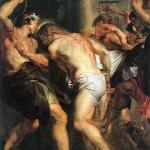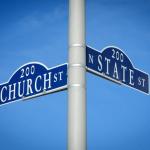
(4-18-09)
***
It’s often heard that 7 out of 10 Catholics disbelieve in the Church’s teaching on the Holy Eucharist. A quick Google search along these lines shows that many Catholics have accepted these figures, based on polling data. It’s nothing new or unknown among Catholics at all. I have accepted this bit of “common knowledge” myself in the past.
But is it correct? On occasion I have heard otherwise, and have seen some materials indicating that the situation is far more complex than that. Curious, I tried to find more data today that might challenge this understanding. For example, James D. Davidson, professor of sociology at Purdue University Purdue University, and co-author, with William V. D’Antonio, of American Catholics: Gender, Generation, and Commitment (Alta Mira Press, 2001) and contributor to The Search for Common Ground: What Unites and Divides Catholic Americans (Our Sunday Visitor, 1997), has done extensive study on the polls that arrived at this conclusion, and factors relating to why they arrived at the 70% figure, as summarized in a fascinating 2001 article: “Yes, Jesus is Really There: Most Catholics Still Agree”.
After examining some factors involved in the well-known polls, he also cites other ones that produced a far different result: a Roper poll from 1997 indicated that 82% among American Catholics believed that “the bread and wine used in Mass are actually transformed into the Body and Blood of Jesus Christ.” A CARA poll in 2001 found that 70% accepted that “Jesus Christ is really present” as opposed to 30% who thought “the bread and wine are symbols of Jesus.” Davidson cites several additional studies and concludes that, while belief in the Real Presence is declining somewhat, it is nowhere near as bleak as the 1992 Gallup and 1994 Times/CBS studies made out. It’s a case study of how to ask poll questions, and how the question affects the answer. Davidson opined that the 1992 poll (of 519 Catholics) offered four elaborate choices over the phone: the nuances of which would have gone over many people’ heads.
A commenter at Catholic Answers Forums, on 9 January 2008, fully understood the factors that go into polls and the results they can achieve (as a sociology major in college, I’m well acquainted with these sorts of things, and so I should have known better than to uncritically accept the 70% figure, myself):
I keep hearing that figure but I have no idea whether or not it is true. I suspect it is false. No one has ever conducted such a poll of the parishioners in my parish; if they did, I’m confident that number of believers in the real presence would be quite high. Polling is hardly an infallible endeavor. If the source was in fact from a Gallup poll conducted 10 years ago, it would be instructive to see how the questions were worded and how the respondents were selected. What percentage of people believe in the validity of poll data extrapolated to general populations?
Even a non-Catholic who commented two days later understood this:
I’m not Catholic, in fact I am an anti-Catholic. Anyway, in the poll that I saw which is likely the one being discussed here the folks answering the poll had to choose the correct theological definition of the “real presence” from four different answers. I forgot how the answers were worded but not being able to choose the correct technical definition of a doctrine doesn’t mean that the folks rejected the idea. Maybe it means that 70% of the people polled needed to attend better catechism classes but it doesn’t prove anything else. So, I am quite sure the number of catholics who believe in the real presence is quite a bit higher than 30%, though they may grasp the theology behind their belief as well as they should.
The late Fr. Richard John Neuhaus, in the 11 January 2008 issue of the widely read journal First Things, noted similar findings from an even more recent study:
. . . American Catholics Today: New Realities of Their Faith and Their Church, edited by William V. DAntonio and his sociological colleagues (Rowman & Littlefield). . . .
The research behind the book was sponsored by the National Catholic Reporter, the premier voice of liberal Catholicism in this country, but, to their credit, the authors generally keep their liberal leanings in check. . . .
There are also items of real interest. For instance, 81 percent say that “belief that Jesus is really present in the Eucharist is essential in their understanding of the Catholic faith. Keep in mind that the survey is of a cross section of the 65 million Catholics in the U.S. (although Latinos are greatly underrepresented). Among the more highly committed Catholics, it is reasonable to assume that belief in the Real Presence is considerably higher than 81 percent. This is worth keeping in mind because some years ago a clumsily worded question in a survey came up with the conclusion that only one third of Catholics believed in the Real Presence, and that finding still crops up in discussions on the state of Catholicism. Among active Catholics, belief in the Real Presence, as also in the Incarnation, the Virgin Birth, and the Resurrection of Jesus, edges up toward unanimity.
In any event, counting heads has no bearing whatever on the status of Catholic dogma and the fact that we Catholics can resolve doctrinal disputes, whereas Protestantism has lost that ability, due to its first principles. This is what Catholic apologists contend — not that unity automatically occurs in practice, which is obviously not the case, since liberalism and nominalism still are huge problems in Catholicism in terms of the views of poorly catechized individuals, who poorly understand or reject various Catholic teachings.
***
Photo credit: Image by “wynpnt” (May 2017) [Pixabay / CC0 Creative Commons public domain license]
***

















